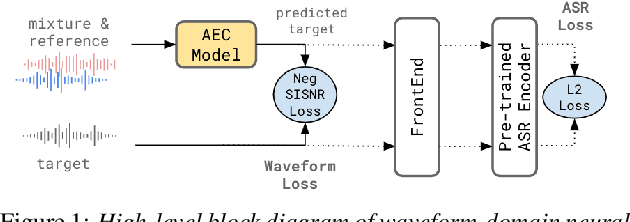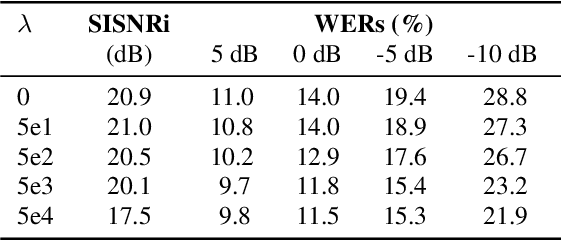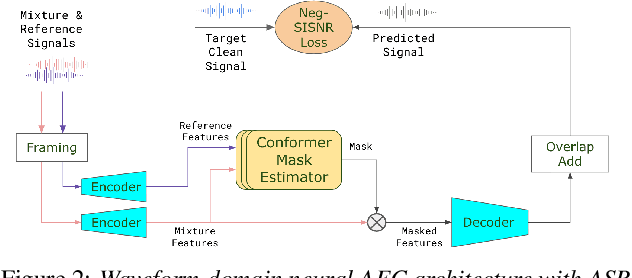Turaj Zakizadeh Shabestary
A Conformer-based Waveform-domain Neural Acoustic Echo Canceller Optimized for ASR Accuracy
May 06, 2022



Abstract:Acoustic Echo Cancellation (AEC) is essential for accurate recognition of queries spoken to a smart speaker that is playing out audio. Previous work has shown that a neural AEC model operating on log-mel spectral features (denoted "logmel" hereafter) can greatly improve Automatic Speech Recognition (ASR) accuracy when optimized with an auxiliary loss utilizing a pre-trained ASR model encoder. In this paper, we develop a conformer-based waveform-domain neural AEC model inspired by the "TasNet" architecture. The model is trained by jointly optimizing Negative Scale-Invariant SNR (SISNR) and ASR losses on a large speech dataset. On a realistic rerecorded test set, we find that cascading a linear adaptive AEC and a waveform-domain neural AEC is very effective, giving 56-59% word error rate (WER) reduction over the linear AEC alone. On this test set, the 1.6M parameter waveform-domain neural AEC also improves over a larger 6.5M parameter logmel-domain neural AEC model by 20-29% in easy to moderate conditions. By operating on smaller frames, the waveform neural model is able to perform better at smaller sizes and is better suited for applications where memory is limited.
A Neural Acoustic Echo Canceller Optimized Using An Automatic Speech Recognizer And Large Scale Synthetic Data
Jun 01, 2021



Abstract:We consider the problem of recognizing speech utterances spoken to a device which is generating a known sound waveform; for example, recognizing queries issued to a digital assistant which is generating responses to previous user inputs. Previous work has proposed building acoustic echo cancellation (AEC) models for this task that optimize speech enhancement metrics using both neural network as well as signal processing approaches. Since our goal is to recognize the input speech, we consider enhancements which improve word error rates (WERs) when the predicted speech signal is passed to an automatic speech recognition (ASR) model. First, we augment the loss function with a term that produces outputs useful to a pre-trained ASR model and show that this augmented loss function improves WER metrics. Second, we demonstrate that augmenting our training dataset of real world examples with a large synthetic dataset improves performance. Crucially, applying SpecAugment style masks to the reference channel during training aids the model in adapting from synthetic to real domains. In experimental evaluations, we find the proposed approaches improve performance, on average, by 57% over a signal processing baseline and 45% over the neural AEC model without the proposed changes.
 Add to Chrome
Add to Chrome Add to Firefox
Add to Firefox Add to Edge
Add to Edge